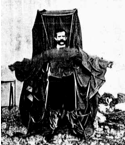The amazing thing about the flight of animals is the seemingly simple nature yet unbelievable complexity of their evolved structures. You would think that to mimic a flying squirrel would be easy, right? You know, just slap on a pair of wings and jump off of something. It couldn’t be that difficult.
Wrong.
It has taken almost a full century for skydivers and base jumpers to perfect the art of creating and using the wingsuit.
It all began in 1912 when Austrian tailor and inventor Franz Reighelt made a parachute jacket. Yes, a parachute jacket. It appeared just as any other jacket would, with a few extra bits and pieces here and there. Unlike the parachutes of his day, this one weighed only about 9 kilos (20 lbs).
After multiple tests on dummies off of balconies and buildings, he received clearance to test a dummy off of the first floor of the Eifel Tower. In a state of confidence, because of the press and many spectators at the event, Reighelt decided to test it himself. His equipment malfunctioned and he suffered a fatal fall, but his ideas prevailed.

Franz Reighelt modeling his parachute jacket in 1912
Modern Wingsuits
Since 1912, the world of wingsuits has made leaps and bounds (quite literally). It has come to the point where the science of flight is being properly understood and manipulated accordingly.
Using the equation for terminal velocity (the point in which drag force=gravitational force), these adrenaline junkies have learned to manipulate their speed as well as control.

This is where v=terminal velocity, mg=weight, C=drag coefficient, ρ=air density, and A=surface area
Simply put, a skydiver can adjust the surface area of his body that is perpendicular to his velocity vector and change his speed drastically.
Using the aerodynamic force of drag they can also control their flight direction and distance. With the proper body position most wingsuits can help a pilot achieve a 2:1 glide ratio-the exact ratio of the Northern Flying Squirrel (Glaucomys Sabrinus) according to the Journal of Mammalogy.
Below is a video that demonstrates some of the maneuvers possible with a wing suit.
It is clear that through changing the positions of ones shoulders and head affect the angle of attack and thus the flight path. The current world record for furthest distance covered in a wingsuit is an unbelievable 14.35 miles done by Shinichi Ito in 2011.
Resources:
Cordia, Jarno, and Steve Bartels. “Fallrate vs Glide Ratio.” Team Fly Like Brick – Wingsuit Flight, Coaching and Instruction.
“February 4 | Franz Reichelt.” Web log post. A Death a Day. 4 Feb. 2008.
“- Explore Records – Guinness World Records.” Guinness World Records – Home of the Longest, Shortest, Fastest, Tallest Facts and Feats.
3 Comments
Nick posted on September 26, 2011 at 6:16 pm
This is SO well done! It makes sense that the physics behind the “wing suits” would be equivalent to the flying squirrel- nature, and the human mind, never seizes to amaze me!! Really really well done, thanks for sharing!!
Lorena Barba posted on September 27, 2011 at 9:09 am
Great post, David!
But, ehem, that would be 14.35 *what*???
David Villari posted on September 27, 2011 at 10:37 am
Woops- 14.35 miles!